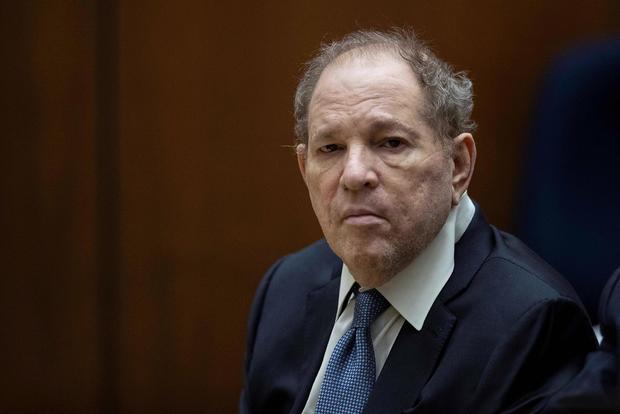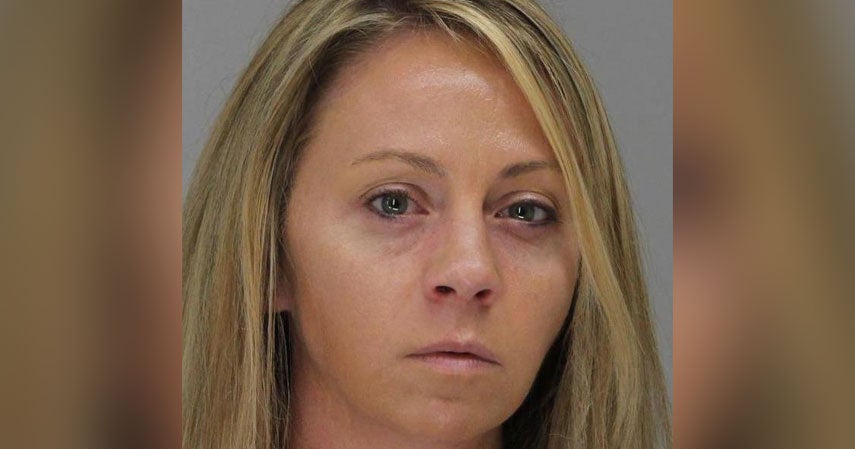CBS News
Harvey Weinstein to appear in NY court next week, experts weigh in on possible retrial

Film mogul Harvey Weinstein is set to appear in a New York City court next week, the first step in potentially retrying the 72-year-old after his 2020 rape conviction was overturned.
On Thursday, New York’s Court of Appeals threw out the conviction of the onetime movie powerbroker, who prosecutors say forced young actors to submit to his prurient desires by dangling his ability to make or break their careers.
He was convicted of forcibly performing oral sex on a TV and film production assistant and of third-degree rape for an attack on an aspiring actor in 2013.
The appeals court in a 4-3 decision vacated a 23-year jail sentence and ordered a retrial of Weinstein, saying the trial judge erred by letting three women testify about allegations that were not part of the charges and by permitting questions about Weinstein’s history of “bad behavior” if he testified. He did not.
The Manhattan district attorney’s office has said it intends to pursue a retrial. Prosecutors will work off the same indictment, albeit excluding the charges he was acquitted of four years ago.
Etienne Laurent/AFP/Getty Images
“We will do everything in our power to retry this case, and remain steadfast in our commitment to survivors of sexual assault,” the district attorney’s office said in a statement Friday, according to the Associated Press.
Weinstein remains jailed after he was also convicted in a similar case in California.
But when could this potential retrial happen? Experts told the Associated Press that it won’t be coming to a courtroom anytime soon, if ever. They said it really is up to the witnesses, who will need to decide if they want to take the stand again.
“I think there won’t be a trial in the end,” said Joshua Naftalis, a former Manhattan federal prosecutor now in private practice. “I don’t think he wants to go through another trial, and I don’t think the state wants to try him again.”
Naftalis said both sides may seek a resolution such as a plea that will eliminate the need to put his accusers through the trauma of a second trial.
Deborah Tuerkheimer, a professor at Northwestern University Pritzker School of Law and former assistant district attorney in Manhattan, said whether there is a second trial will “hinge on the preferences of the women who would have to testify again and endure the ordeal of a retrial.”
“I think ultimately this will come down to whether they feel it’s something they want to do, are able to do,” she said.
Jane Manning, director of the nonprofit Women’s Equal Justice, which provides advocacy services to sexual assault survivors, agreed “the biggest question is whether the two women are willing to testify again.”
The lawyers say the road to a trial will include monthslong battles between lawyers over what evidence and testimony will be allowed at a retrial.
A woman Weinstein was sent to prison for sexually assaulting said Friday she is considering whether she would testify at any retiral.
Miriam Haley told reporters she is still processing the state Court of Appeals’ decision and is considering numerous factors, including the trauma of having to prepare for another trial and again relive everything that happened to her.
“It was retraumatizing and grueling and exhausting and all the things,” she said during a news conference with her attorney, Gloria Allred. “I definitely don’t want to actually go through that again. But for the sake of keeping going and doing the right thing and because it is what happened, I would consider it.”
Haley, a former “Project Runway” production assistant also known as Mimi Haleyi, testified at Weinstein’s trial that she repeatedly told Weinstein “no” when he attacked her inside his apartment in July 2006, forcibly performing oral sex on her. In a 2020 civil lawsuit, Haley said she was left with horror, humiliation and pain that persists.
New York Governor Kathy Hochul said Friday that her office is analyzing the scale of the decision and how the state can make sure that all women feel safe coming forward.
“I don’t want this to be a moment of stifling the environment that was created where finally we were calling out people who were abusing women in their presence,” Hochul said. “We don’t want to have any setbacks where there’s this sense that you now have to be silenced, and that’s something that we have to protect.”
CBS News
In praise of Seattle-style teriyaki

Watch CBS News
Be the first to know
Get browser notifications for breaking news, live events, and exclusive reporting.
CBS News
Gazan chefs cook up hope and humanity for online audience

Renad Atallah is an unlikely internet sensation: a 10-year-old chef, with a repertoire of simple recipes, cooking in war-torn Gaza. She has nearly a million followers on Instagram, who’ve witnessed her delight as she unpacks parcels of food aid.
CBS News
We interviewed Renad via satellite, though we were just 50 miles away, in Tel Aviv. [Israel doesn’t allow outside journalists into Gaza, except on brief trips with the country’s military.]
“There are a lot of dishes I’d like to cook, but the ingredients aren’t available in the market,” Renad told us. “Milk used to be easy to buy, but now it’s become very expensive.”
I asked, “How does it feel when so many people like your internet videos?”
“All the comments were positive,” she said. “When I’m feeling tired or sad and I want something to cheer me up, I read the comments.”
We sent a local camera crew to Renad’s home as she made Ful, a traditional Middle Eastern bean stew. Her older sister Noorhan says they never expected the videos to go viral. “Amazing food,” Noorhan said, who added that her sibling made her “very surprised!”
After more than a year of war, the Gaza Strip lies in ruins. Nearly everyone has been displaced from their homes. The United Nations says close to two million people are experiencing critical levels of hunger.
Hamada Shaqoura is another chef showing the outside world how Gazans are getting by, relying on food from aid packages, and cooking with a single gas burner in a tent.
Shaqoura also volunteers with the charity Watermelon Relief, which makes sweet treats for Gaza’s children.
In his videos online, Shaqoura always appears very serious. Asked why, he replied, “The situation does not call for smiling. What you see on screen will never show you how hard life is here.”
Before dawn one recent morning in Israel, we watched the UN’s World Food Program load nearly two dozen trucks with flour, headed across the border. The problem is not a lack of food; the problem is getting the food into the Gaza Strip, and into the hands of those who desperately need it.
The UN has repeatedly accused Israel of obstructing aid deliveries to Gaza. Israel’s government denies that, and claims that Hamas is hijacking aid.
“For all the actors that are on the ground, let the humanitarians do their work,” said Antoine Renard, the World Food Program’s director in the Palestinian territories.
I asked, “Some people might see these two chefs and think, well, they’re cooking, they have food.”
“They have food, but they don’t have the right food; they’re trying to accommodate with anything that they can find,” Renard said.
Even in our darkest hour, food can bring comfort. But for many in Gaza, there’s only the anxiety of not knowing where they’ll find their next meal.
For more info:
Story produced by Mikaela Bufano. Editor: Carol Ross.
See also:
“Sunday Morning” 2024 “Food Issue” recipe index
Delicious menu suggestions from top chefs, cookbook authors, food writers, restaurateurs, and the editors of Food & Wine magazine.
CBS News
A study to devise nutritional guidance just for you

It’s been said the best meals come from the heart, not from a recipe book. But at this USDA kitchen, there’s no pinch of this, dash of that, no dollops or smidgens of anything. Here, nutritionists in white coats painstakingly measure every single ingredient, down to the tenth of a gram.
Sheryn Stover is expected to eat every crumb of her pizza; any tiny morsels she does miss go back to the kitchen, where they’re scrutinized like evidence of some dietary crime.
Stover (or participant #8180, as she’s known) is one of some 10,000 volunteers enrolled in a $170 million nutrition study run by the National Institutes of Health. “At 78, not many people get to do studies that are going to affect a great amount of people, and I thought this was a great opportunity to do that,” she said.
CBS News
It’s called the Nutrition for Precision Health Study. “When I tell people about the study, the reaction usually is, ‘Oh, that’s so cool, can I do it?'” said coordinator Holly Nicastro.
She explained just what “precise” precisely means: “Precision nutrition means tailoring nutrition or dietary guidance to the individual.”
The government has long offered guidelines to help us eat better. In the 1940s we had the “Basic 7.” In the ’50s, the “Basic 4.” We’ve had the “Food Wheel,” the “Food Pyramid,” and currently, “My Plate.”
CBS News
They’re all well-intentioned, except they’re all based on averages – what works best for most people, most of the time. But according to Nicastro, there is no one best way to eat. “We know from virtually every nutrition study ever conducted, we have inner individual variability,” she said. “That means we have some people that are going to respond, and some people that aren’t. There’s no one-size-fits-all.”
The study’s participants, like Stover, are all being drawn from another NIH study program called All Of Us, a massive undertaking to create a database of at least a million people who are volunteering everything from their electronic health records to their DNA. It was from that All of Us research that Stover discovered she has the gene that makes some foods taste bitter, which could explain why she ate more of one kind of food than another.
Professor Sai Das, who oversees the study at Tufts University, says the goal of precision nutrition is to drill down even deeper into those individual differences. “We’re moving away from just saying everybody go do this, to being able to say, ‘Okay, if you have X, Y and Z characteristics, then you’re more likely to respond to a diet, and somebody else that has A, B and C characteristics will be responding to the diet differently,'” Das said.
It’s a big commitment for Stover, who is one of 150 people being paid to live at a handful of test sites around the country for six weeks – two weeks at a time. It’s so precise she can’t even go for a walk without a dietary chaperone. “Well, you could stop and buy candy … God forbid, you can’t do that!” she laughed.
While she’s here, everything from her resting metabolic rate, her body fat percentage, her bone mineral content, even the microbes in her gut (digested by a machine that essentially is a smart toilet paper reading device) are being analyzed for how hers may differ from someone else’s.
Nicastro said, “We really think that what’s going on in your poop is going to tell us a lot of information about your health and how you respond to food.”
CBS News
Stover says she doesn’t mind, except for the odd sounds the machine makes. While she is a live-in participant, thousands of others are participating from their homes, where electronic wearables track all kinds of health data, including special glasses that record everything they eat, activated when someone starts chewing. Artificial intelligence can then be used to determine not only which foods the person is eating, but how many calories are consumed.
This study is expected to be wrapped up by 2027, and because of it, we may indeed know not only to eat more fruits and vegetables, but what combination of foods is really best for us. The question that even Holly Nicastro can’t answer is, will we listen? “You can lead a horse to water; you can’t make them drink,” she said. “We can tailor the interventions all day. But one hypothesis I have is that if the guidance is tailored to the individual, it’s going to make that individual more likely to follow it, because this is for me, this was designed for me.”
For more info:
Story produced by Mark Hudspeth. Editor: Ed Givnish.
“Sunday Morning” 2024 “Food Issue” recipe index
Delicious menu suggestions from top chefs, cookbook authors, food writers, restaurateurs, and the editors of Food & Wine magazine.














